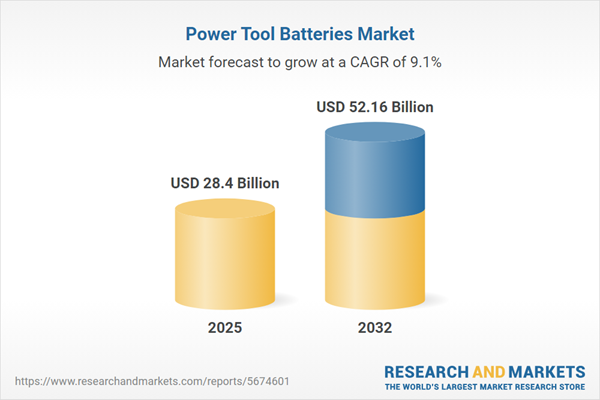Speak directly to the analyst to clarify any post sales queries you may have.
The power tool batteries market is transforming as industries prioritize efficiency, digital transformation, and environmental responsibility. In this shifting landscape, reliable market intelligence empowers senior leaders to act decisively and position their organizations for resilience and growth.
Market Snapshot: Power Tool Batteries Market Growth and Competition
The global power tool batteries market is set for consistent expansion from 2024 to 2032, registering a compound annual growth rate (CAGR) of 9.08%. Growth is driven by robust uptake of cordless solutions across construction, automotive, manufacturing, and consumer segments. Battery innovation is advancing rapidly as organizations invest heavily in chemistry improvements, digitalization, and supply chain enhancements. Competitive dynamics are shaped by strategic investment in research, as well as the formation of partnerships and expansion of regional distribution networks. Both established and emerging players are adjusting their strategies to accommodate changing regulations, local market preferences, and the evolving expectations of end users worldwide.
Scope & Segmentation of the Power Tool Batteries Market
- Chemistry: Lithium Ion, Nickel Cadmium, and Nickel Metal Hydride form the core technologies in today’s market. Lithium Ion remains preferred for energy density and lightweight construction, while ongoing advances focus on sustainability and streamlined compliance in manufacturing.
- Voltage: Options range from less than 12 Volts to above 24 Volts, spanning needs from light residential to demanding industrial contexts. This diversity ensures adaptability across operational intensities.
- Application: Power tool batteries support activities including cutting, drilling, fastening, grinding, polishing, measuring, testing, welding, and soldering, reflecting the need for versatility in both professional and home environments.
- End User: Key sectors—automotive, construction, industrial, and residential—drive battery development. Specific focus is placed on portability, durability, and adherence to emerging safety requirements.
- Distribution Channel: Products are accessed through both offline and online channels, enabling flexible purchasing and responsive aftermarket services according to regional logistics and customer expectations.
- Geography: Market activity is pronounced across the Americas, Europe, Middle East, Africa, and Asia-Pacific, with each area displaying unique regulatory and infrastructure challenges. Tailored go-to-market strategies are essential for local success.
- Leading Companies: Industry leaders include Robert Bosch GmbH, Stanley Black & Decker, Techtronic Industries, Makita Corporation, Hilti Aktiengesellschaft, Koki Holdings, Chervon Holdings, Metabowerke, Festool GmbH & Co. KG, Emerson Electric, LG Chem, Panasonic, SAMSUNG SDI, Contemporary Amperex Technology, and Sony Group Corporation. These firms are distinguished by their focus on product innovation and extensive global distribution capabilities.
Key Takeaways for Senior Decision-Makers
- Innovations in battery materials and smarter management systems are lengthening operational life and improving reliability in diverse tool applications.
- Recycling programs and advancements in eco-friendly chemistry strengthen sustainable practices and support adherence to new regulatory expectations.
- Digital capabilities such as advanced diagnostics and predictive maintenance are reshaping asset management and diversifying after-sales opportunities.
- Agile supply chain management has become crucial in adapting to international logistics requirements and varied compliance landscapes.
- Strategic collaboration among equipment manufacturers, battery providers, and recycling experts contributes to closed-loop systems, enhancing both environmental stewardship and stakeholder confidence.
- Aligning technology and voltage selection with intended applications directly improves durability, operational efficiency, and workplace safety across segments.
Tariff Impact: Responding to U.S. Trade Policy Dynamics
Forthcoming changes in U.S. tariffs starting in 2025 present fresh complexities for the power tool batteries market supply chain. Companies are adapting by reinforcing domestic production, diversifying supplier relationships, and increasing investment in local manufacturing. These approaches help organizations weather uncertainty, sustain cost competitiveness, and manage evolving trade conditions. Ongoing assessment of procurement and operational models is advised to ensure continuing stability amid regulatory changes.
Methodology & Data Sources
This report combines insights from supply chain leaders, technical specialists, and market influencers. Findings were validated through an in-depth review of industry publications, patent databases, and technical reports, ensuring that scenario analysis informs actionable recommendations.
Why This Report Matters
- Delivers the segmented, up-to-date market intelligence needed for risk management and opportunity identification as sector dynamics shift.
- Enables effective investment decisions, best-practice benchmarking, and regional market-entry strategies that reflect local application requirements.
- Advises on integrating sustainability and compliance, equipping organizations to respond to evolving regulatory mandates and operational benchmarks.
Conclusion
Staying ahead in the power tool batteries market requires proactive technology adoption, sustainability leadership, and adaptable supply chain strategies. Well-informed executives are best positioned to guide their organizations through industry developments and regulatory challenges.
Additional Product Information:
- Purchase of this report includes 1 year online access with quarterly updates.
- This report can be updated on request. Please contact our Customer Experience team using the Ask a Question widget on our website.
Table of Contents
3. Executive Summary
4. Market Overview
7. Cumulative Impact of Artificial Intelligence 2025
List of Figures
Samples

LOADING...
Companies Mentioned
The key companies profiled in this Power Tool Batteries market report include:- Robert Bosch GmbH
- Stanley Black & Decker, Inc.
- Techtronic Industries Co. Ltd.
- Makita Corporation
- Hilti Aktiengesellschaft
- Koki Holdings Co., Ltd.
- Chervon Holdings Limited
- Metabowerke GmbH
- Festool GmbH & Co. KG
- Emerson Electric Co.
- LG Chem Ltd.
- Panasonic Corporation
- SAMSUNG SDI CO.,LTD.
- Contemporary Amperex Technology Co. Limited
- Sony Group Corporation
Table Information
| Report Attribute | Details |
|---|---|
| No. of Pages | 186 |
| Published | October 2025 |
| Forecast Period | 2025 - 2032 |
| Estimated Market Value ( USD | $ 28.4 Billion |
| Forecasted Market Value ( USD | $ 52.16 Billion |
| Compound Annual Growth Rate | 9.0% |
| Regions Covered | Global |
| No. of Companies Mentioned | 16 |









